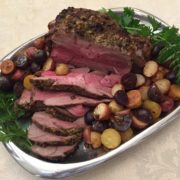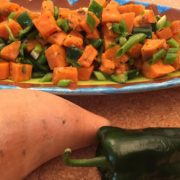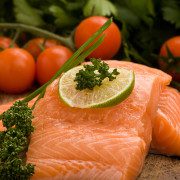Rosemary Roasted Leg of Lamb with Tri-Color Potatoes
Of the bijillion hours (or so it seems) I’ve spent happily cooking, this is only the second time in my life I’ve cooked lamb. The first time was last Christmas requested by my cousin Dax and was possible thanks to my very dear friend Lorena who patiently coached me through it, taking my multiple frantic calls on Christmas Eve. The results (after panic subsided that I was either burning it or potentially serving it raw) exceeded my expectations and encouraged me to try again, this time venturing with seasonings.
As will all meat I purchase, I buy organic. Yes it’s crazy expensive, but this is a once, maybe twice a year expense.
The secret to lamb, Lorena taught me, is to trim ALL the fat off.
I like (surprise! after all there is a reason this food blog is Color My Food) color in my food first because it’s pretty and second because color generally means more nutrients, so I looked for the multi-colored potatoes and was glad to find them. My second option was to use 1 1/2 pound diced russet potatoes mixed with 1 1/2 pound diced sweet potatoes.
- 2 large lemons
- 1/4 cup fresh rosemary finely chopped
- 2 tablespoons garlic minced
- 1 tablespoons olive oil
- 2 tablepsoons fresh lemon juice
- 1 teaspoon salt
- 1/2 teaspoon black pepper coarse
- 1 6-pound leg of lamb ask butcher to trim off all the fat
- 2 1/2 pounds tri-color potatoes scrubbed clean
- 2 tablespoons rosemary finely chopped
- 1 tablespoon garlic minced
- 1 tablespon olive oil
- 1/2 teaspoon salt
- Preheat oven to 475°F.
- Zest the two lemons.
- Mix zest in a small bowl with 4 tablespoons finely chopped rosemary, 2 tablespoons minced garlic, 1 tablespoon lemon juice, 2 tablespoons olive oil, salt and pepper.
- Place leg of lamb in roasting pan. Cut slits all over lamb and rub rosemary mixture over lamb, rubbing into slits.
- Place leg of lamb into oven for 20 minutes.
- Meanwhile, cut potatoes in half.
- Mix 2 tablespoons chopped rosemary, 1 tablespoon minced garlic, 1 tablespoon oil and 1/2 teaspoon salt. Sprinkle over potatoes and mix.
- Turn heat down to 350°F. Remove lamb from oven and place potatoes around lamb. Put back in oven and roast 40 – 50 minutes, stirring potatoes occasionally, until meat thermometer registers 140°F
- Remove from oven and let rest for 15 minutes.
- Transfer lamb to a cutting board and slice thin across the grain. Place on serving platter, surround with potatoes and garnish with parsley or a few rosemary sprigs.
A Color My food recipe



